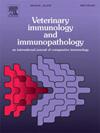Chicken adipose tissue is differentially involved in primary and secondary regional immune response to NDV through miR-20a-5p-NR4A3 pathway
IF 1.4
3区 农林科学
Q4 IMMUNOLOGY
引用次数: 0
Abstract
The mammalian adipose tissue (AT) plays a key role in regulating immune function and anti-infective protection to maintain tissue regional homeostasis. However, it is still unclear whether there are differences in the participation of AT in primary and secondary immune response, and whether avian AT has the similar immune function characteristics to mammals. In this study, we used Newcastle disease virus (NDV) attenuated vaccine to induce primary and secondary immune response in chickens, and the changes of the key regulatory gene NR4A3 (nuclear receptor subfamily 4 group A member 3) of T cells activation and its targeted miR-20a-5p were detected by quantitative real-time PCR (qRT-PCR). The results showed that NR4A3 actively participated in immune response of AT, and showed significant differences in expression activities between the two immune processes. "MiR-20a-5p/NR4A3" pathway was a potential molecular mechanism involved in the regulation of immune function in AT. Moreover, AT responded differently to the primary and secondary immune response possibly through the different patterns of source, apoptosis and migration for lymphocytes (such as CD8β+ T cells). This study can provide directional guidance for further studying immune functions of avian AT.
鸡脂肪组织通过miR-20a-5p-NR4A3途径不同地参与NDV的原发性和继发性区域免疫应答。
哺乳动物脂肪组织(AT)在调节免疫功能和抗感染保护中发挥关键作用,维持组织局部稳态。然而,AT参与一次免疫应答和二次免疫应答是否存在差异,禽类AT是否具有与哺乳动物相似的免疫功能特征,目前尚不清楚。本研究利用新城疫病毒(NDV)减毒疫苗诱导鸡的一次和二次免疫应答,采用实时荧光定量PCR (qRT-PCR)检测T细胞活化关键调控基因NR4A3(核受体亚家族4组A成员3)及其靶基因miR-20a-5p的变化。结果显示,NR4A3积极参与AT的免疫应答,且在两种免疫过程中表达活性存在显著差异。“MiR-20a-5p/NR4A3”通路是参与AT免疫功能调控的潜在分子机制。此外,AT对原发性和继发性免疫应答的不同反应可能与淋巴细胞(如CD8β+ T细胞)的来源、凋亡和迁移模式不同有关。本研究可为进一步研究禽AT的免疫功能提供方向性指导。
本文章由计算机程序翻译,如有差异,请以英文原文为准。
求助全文
约1分钟内获得全文
求助全文
来源期刊
CiteScore
3.40
自引率
5.60%
发文量
79
审稿时长
70 days
期刊介绍:
The journal reports basic, comparative and clinical immunology as they pertain to the animal species designated here: livestock, poultry, and fish species that are major food animals and companion animals such as cats, dogs, horses and camels, and wildlife species that act as reservoirs for food, companion or human infectious diseases, or as models for human disease.
Rodent models of infectious diseases that are of importance in the animal species indicated above,when the disease requires a level of containment that is not readily available for larger animal experimentation (ABSL3), will be considered. Papers on rabbits, lizards, guinea pigs, badgers, armadillos, elephants, antelope, and buffalo will be reviewed if the research advances our fundamental understanding of immunology, or if they act as a reservoir of infectious disease for the primary animal species designated above, or for humans. Manuscripts employing other species will be reviewed if justified as fitting into the categories above.
The following topics are appropriate: biology of cells and mechanisms of the immune system, immunochemistry, immunodeficiencies, immunodiagnosis, immunogenetics, immunopathology, immunology of infectious disease and tumors, immunoprophylaxis including vaccine development and delivery, immunological aspects of pregnancy including passive immunity, autoimmuity, neuroimmunology, and transplanatation immunology. Manuscripts that describe new genes and development of tools such as monoclonal antibodies are also of interest when part of a larger biological study. Studies employing extracts or constituents (plant extracts, feed additives or microbiome) must be sufficiently defined to be reproduced in other laboratories and also provide evidence for possible mechanisms and not simply show an effect on the immune system.

 求助内容:
求助内容: 应助结果提醒方式:
应助结果提醒方式:


